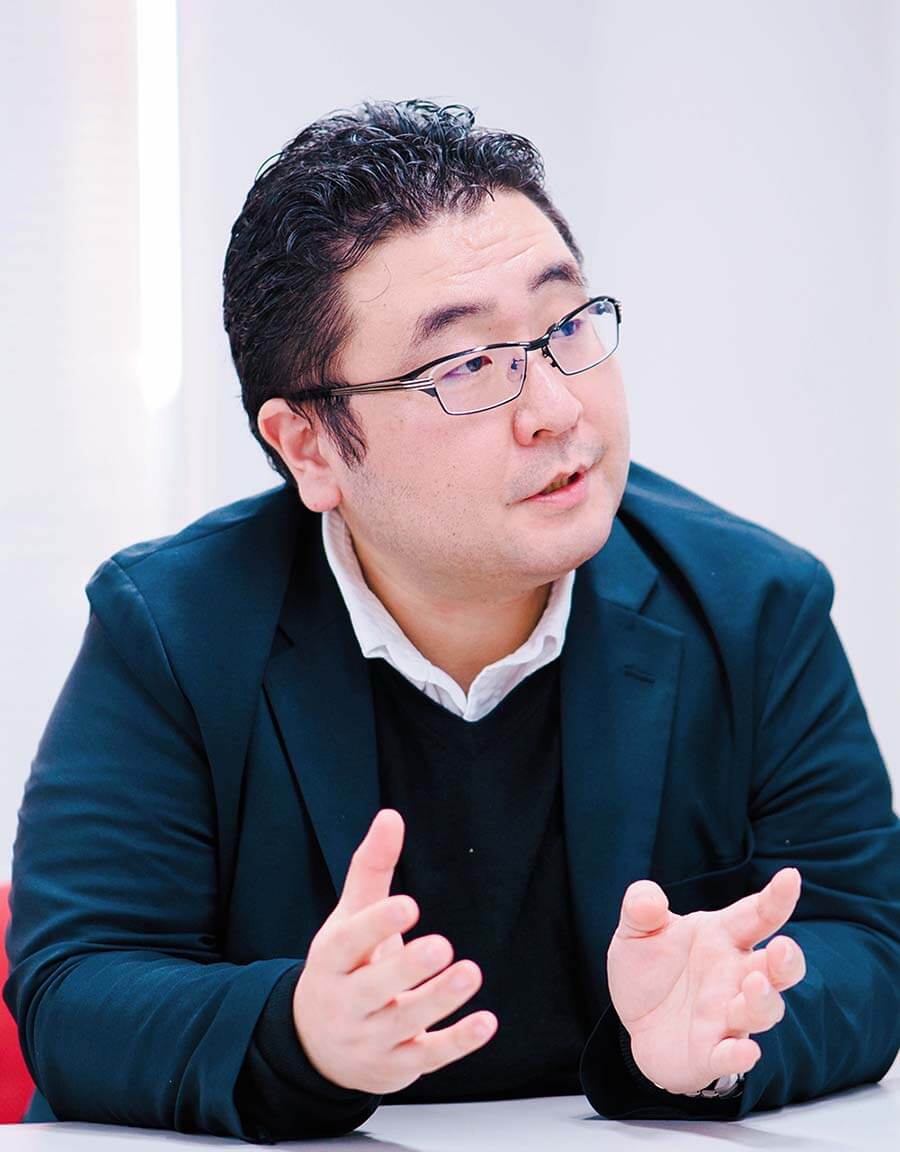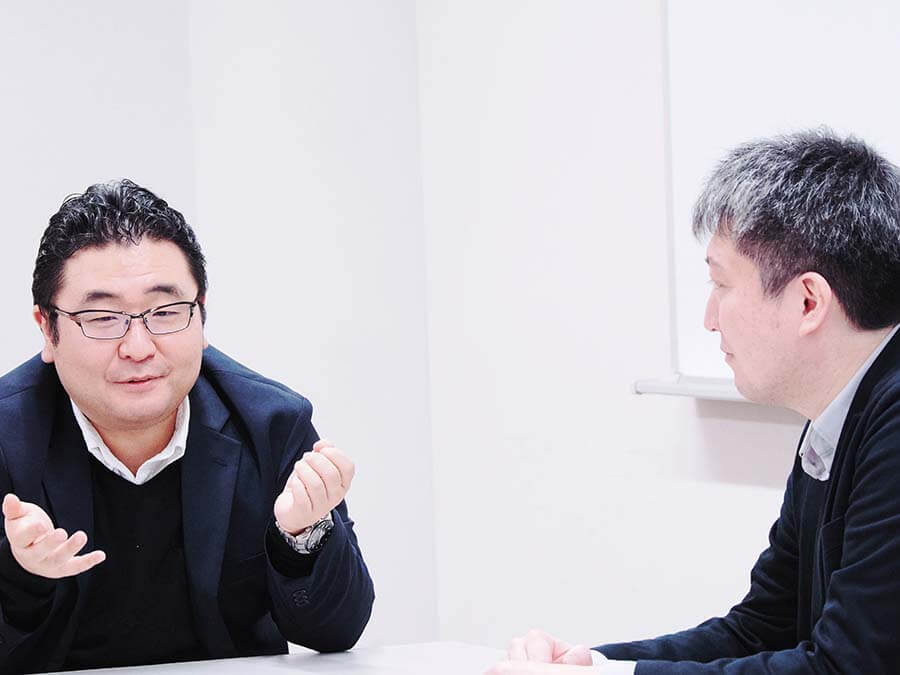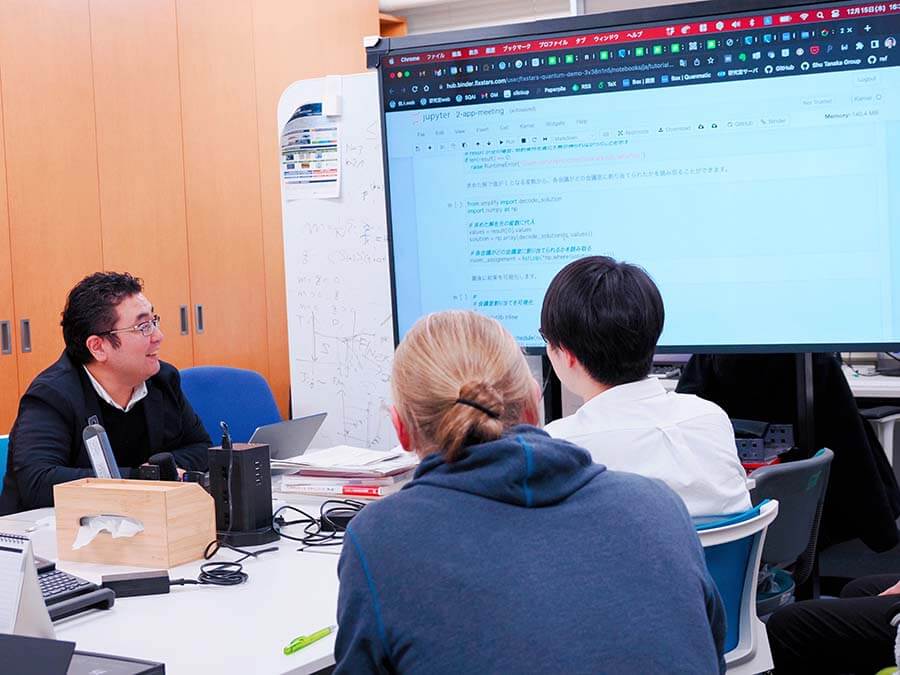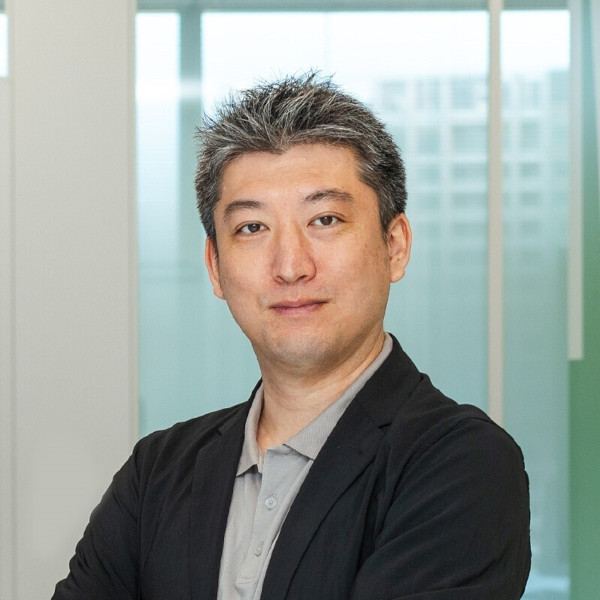This website uses cookies to improve your user experience on this site. By continuing to view
this site, you agree to our group's privacy
policy .


Members of Shu Tanaka Group
Prof. Shu Tanaka
Associate Professor, Department of Applied Physics and Physico-Informatics, Faculty of Science and
Technology, Keio University
Core Director of Quantum Computing Core, Human Biology-Microbiome-Quantum
Research Center (WPI-Bio2Q), Keio University
Project Manager of Mitou Target Program,
Information-technology Promotion Agency, Japan (Fourth from the
left)
In the quantum computer industry, Prof. Tanaka has always focused on "social implementation" and has conducted research focusing on practical use cases, despite his position as a university researcher. We interviewed him about his encounter with quantum annealing, the prospects of quantum computers, the concept of "quantum bilingualism" that promotes the use of quantum computers, and Prof. Tanaka's use of Fixstars Amplify.
When I was an undergraduate student, I was enrolled in the Nishimori Group (Prof. Hidetoshi Nishimori,
Theoretical Physics) at the Tokyo Institute of Technology. Prof. Nishimori is the
inventor of quantum annealing.
As an undergraduate, I immersed myself in the theory of statistical mechanics (a branch of physics), but
gradually began
to explore a wide range of applied research with statistical mechanics as my primary focus. After entering the
Department of Physics, Graduate School of Science, the University of Tokyo as a graduate student, I
have been pursuing computational physics (research in physics using computer simulations). Thanks to my good
friends, I had opportunities to learn machine learning and other IT technologies earlier that are
currently trending.
After completing the doctoral program, I was working on research at various institutions, including the
Institute for
Solid State Physics at the University of Tokyo and the Quantum Computer Research Center at Kinki University's
Graduate
School of Science and Engineering. Under those circumstances, I became deeply involved in research aimed at
the
practical application of quantum annealing as a physicist.
I conducted joint research with experimental researchers and also belonged to an experimental laboratory,
which I think
is rare among theoretical researchers. Through these experiences, I realized that theoretical research
contributed to
real world applications.
The turning point for me was the launch of the world's first quantum annealing machine, "D-Wave," which was
developed by
D-Wave Systems of Canada in 2011. It made a great impact on me, because "D-Wave" was the actual working
machine based on Prof. Nishimori's quantum
annealing theory *1.
At that time, I reaffirmed the need to address not only theoretical research on quantum computers and quantum
annealing,
but also the question, "How should quantum annealing machines be used in the real world?".
Thus, I started full-scale research on quantum annealing and peripheral areas such as practical use cases.
*1 Kadowaki, T., & Nishimori, H. (1998). Quantum annealing in the transverse Ising model. Phys.
Rev. E, 58(5), 5355–5363.
https://doi.org/10.1103/PhysRevE.58.5355
Digital computers (conventional computers), which are now commonplace, originated from vacuum tube computers developed in the 1940s. The original application was to calculate the ballistics of artillery.
Subsequently, the logic circuits used in computers were miniaturized and integrated from transistors to semiconductor integrated circuits. At the same time, advances in software and the expansion of applications (e.g., scientific and technical calculations, office calculations, and personal computers) continued.
Computers have evolved and are now, not only tools of computation, but also tools of communication; creative tools such as creating pictures and music, guiding tools for analysis, judgment, and guidance are all possible with computers.
I believe that quantum computers, the next-generation accelerators *2, will also develop
in such a way. In other words, for the spread of quantum computers, research and development of not
only
"hardware" but also "software"
and "applications" are needed at the same time.
In addition, I think that if people specializing in various fields come into contact with quantum
computers, various
applications and fields of use will be pioneered, and further deepening of the field can be expected.
 Prof. Tanaka (Associate Professor, Department of Applied Physics and
Physico-Informatics, Faculty of Science and Technology, Keio University)
Prof. Tanaka (Associate Professor, Department of Applied Physics and
Physico-Informatics, Faculty of Science and Technology, Keio University)
For example, in recent years, the use of big data has been advancing in various fields with the spread of DX. With that, there is a possibility that user actions that bring the greatest value can be computationally derived from such big data. This type of problem is so called a "combinatorial optimization problem *3" (searching for the optimal one among a huge number of alternatives under complex conditions), and is an area in which quantum annealing is expected to speed up calculations.
In fact, there are many researchers and engineers whose intellectual curiosity and interest are awoken by the concept of quantum computing, namely, "applying physical phenomena to computation" in addition to solving their individual problems. This is why the search for applications of quantum computers in the real world is expected to continue in the future.
*2
Next-generation accelerators
Next-generation accelerators are computers that achieve
faster and more sophisticated processing and analysis than
conventional computational methods using Ising-type computers (annealing quantum computers and Ising machines
using
conventional technologies), NISQ computers, and error-resistant gated quantum computers for the realization of
"Society
5.0".
Science and Technology Policy, Cabinet Office, Government of Japan, "Society 5.0": https://www8.cao.go.jp/cstp/society5_0/ (Note: Japanese only)
*3
Combinatorial optimization problem
Combinatorial optimization problems have high
computational needs in various industries such as manufacturing,
logistics, and finance. It searches for the optimal combination for an objective from among possible
combination
patterns. For example, if we can calculate the optimal pattern for logistics transportation planning or
manufacturing
planning, it will be useful for improving the efficiency of business activities and predicting return on
investment.
On the other hand, the more variables and conditions to be considered, the more rapidly the number of
combination
patterns increases. As the number of variables such as the number of vehicles and delivery destinations in
truck
logistics, and constraints such as the amount of load capacity and availability of drivers, increase, the
calculation to
find the optimal pattern becomes more and more difficult.
Examples: production planning optimization, work shift optimization, route optimization, etc.

Looking back on my own career, I have not always been involved in quantum annealing research. In the past, I conducted research that I was interested in with the research group I was a member of; these experiences are irreplaceable in my current research on quantum annealing. I believe that the concept of "quantum bilingualism," so to speak, in which one has a quantum computer and another specialty, will become more important in the career planning of people in all specialties in the future. It means that you should consider a career design that combines your "core expertise" and "quantum computer application technology". Quantum computers will be a powerful partner for you to make a leap forward in your area of expertise.
Although the field of quantum computing is currently attracting a great deal of attention, I think that it is still at the initial stage. I personally believe that quantum computing should expand greatly in the future, including its practical applications. For this reason, I hope that people with various backgrounds and expertise will start working on quantum computer applications.
In terms of careers, let me also mention human resource development. I am in charge of a course called
"Quantum Computing" in the Department of Physics and Computer Science in the Faculty
of Science and Technology at Keio University, together with Prof. Naoki Yamamoto (Director of the Center for
Quantum
Computing at Keio University).
This is a unique course, even from a global perspective, in which Prof. Yamamoto lectures on gate-based
quantum computer and I lecture on quantum annealing.
Listening to the students, we find that they have a variety of perspectives on our course.
Some are interested in cutting-edge computer technology, others dream of the future development of quantum
physics as a
useful technology.
In order to increase the number of "quantum bilinguals," I always feel that it is necessary to provide a development environment in which not only quantum information specialists but also people from various fields of backgrounds and expertises can work on quantum computing.
I am often asked to give lectures in various places, and I am often asked, "I am interested in quantum computing, but where should I start?". In such situations, I recommend the free use of the quantum computing cloud service "Fixstars Amplify". Here I would like to share my personal experience with Fixstars Amplify.
When I first encountered and used Fixstars Amplify, which includes an application development environment (SDK) and its own execution environment, I was very surprised at how easy it was to code.
In my group, both graduate students and undergraduate students are using Fixstars Amplify to learn and study
quantum
annealing.
Because Fixstars Amplify has extensive sample code, students seem to be able to use it quickly even without
advanced
programming skills. I consider this a very innovative development environment.
As another example, let me introduce the use of Fixstars Amplify in my university lecture on quantum
computers.
One of the assignments in the lecture was to define a combinatorial optimization problem, code it using
Fixstars
Amplify, and write down the results. In my lecture, advanced assignments are for those who are interested and
have time,
so they are not mandatory assignments.
However, more students than I expected were working on them using Fixstars Amplify.
Later, I heard from some of the students that they enjoyed coding.
Many people may feel that it is difficult to use a quantum computer when they first try it out.
However,
by using a development environment such as Fixstars Amplify, it is easy to experience quantum computer
technology and start developing applications that utilize it.
Fixstars Amplify also allows you to run your own programs on various vendors' quantum computers.
Note that there are differences in specifications, calculation models, and programming interfaces per
vendor. For this
reason, if a user wanted to run the same program on multiple machines, she or he would normally have to
develop
different programs specific to each machine. It is time-consuming.
With Fixstars Amplify, you can just write a main program once.
That program is runnable on different vendors' quantum computers with minimal (a few lines) changes.
This feature brings a lot of benefits to us.
Since it is very easy to port your application among the quantum computers of different
companies, it is
possible to
evaluate the usability of each machine, and it can also be used for research to study the performance of
different
machines for the target problem.

In addition to using Fixstars Amplify, which is provided as a cloud service, for research and educational activities on a daily basis, we also collaborate with the Fixstars Group on various projects. Typical examples include social implementation in the national projects "Strategic Innovation Program (SIP, Cabinet Office) *4" and "NEDO*5," and quantum human resource development in the "Mitou Target Program (IPA, Information-technology Promotion Agency, Japan)*6. Prof. Muramatsu's research *7, which was recently published as a user case study of Fixstars Amplify, was also very interesting. We hope that we can continue to collaborate with each other to implement quantum computer technology in society, transcending the boundaries between industry and academia.
*4
Cabinet Office: Strategic Innovation Program
(SIP)
A national project established by the Cabinet Office's Council for Science, Technology and
Innovation to realize science
and technology innovation through management that transcends the boundaries of ministries, agencies, and
traditional
disciplines by exercising a command post function. It addresses social issues that are truly necessary for the
people
and world-leading issues that can contribute to the revitalization of the Japanese economy.
https://www8.cao.go.jp/cstp/gaiyo/sip/ (Note:Japanese only)
Fixstars > Press Release > Technology for Realizing Society 5.0 Using Optics and Quantum: Selected as a
Research and
Development Consignee for Optoelectronic Information Processing
https://news.fixstars.com/2133/ (Note: Japanese only)
*5 New Energy and Industrial Technology Development Organization (NEDO): Integrated
research and development of quantum
computation and Ising computation systems
A project to develop and validate a cloud infrastructure that enables the use of domestic quantum annealing
machines
with a unified interface.
https://nedo-quantum.aist.go.jp/ (Note: Japanese only)
Fixstars > Press Release > NEDO: Adopted for Research and Development of a Common Software Infrastructure for
Using
Quantum Annealing Machines (2018/10).
https://news.fixstars.com/2110/ (Note: Japanese only)
*6 Information-technology Promotion Agency, Japan (IPA): Mitou Target Program
https://www.ipa.go.jp/en/it-talents/mitou.html
The "Mitou Program" is a project aimed at discovering and fostering outstanding IT human resources with
original ideas
and technologies that can create innovations using IT, as well as the ability to make use of these ideas and
technologies. The project is sponsored by the IPA and is characterized by the fact that project managers with
outstanding abilities and achievements who are active at the forefront of industry and academia identify and
adopt human
resources with outstanding potential, and provide guidance and support in the form of accompanying them in
their
creative development.
Fixstars > Press Release > Fixstars Appointed as 2018 Technical Advisor for "Mitou Target Program".
https://news.fixstars.com/2103/ (Note: Japanese only)
*7 Fixstars Amplify was used to develop a fast analysis method that utilizes next-generation
technology
https://amplify.fixstars.com/en/customers/interview/nextgen-analysis
* All information in this article is based on the information available at the time of the interview (December 2022).

Prof. Tanaka has been helping us with various projects, and it was very encouraging for all of us involved to hear again how he is using Fixstars Amplify in his daily educational activities; we feel that we have received some hints for our future product development.
I am sure that there are many people reading this article who are not experts in quantum computers. We hope that you will take the first step toward making your own work or research "quantum bilingual" with quantum computers.
Fixstars Amplify Corporation offers a free opportunity to experience and learn about quantum
computers.
We hope you will take advantage of this service.
We did not have enough time to cover all of his interests in this area, so we are planning a second interview with Prof. Tanaka. Please stay tuned!
Interviewer: Takuji Hiraoka (President and CEO, Fixstars Amplify Corporation)